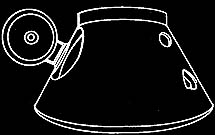MERKUR
MANNED SPACECRAFT
This
Merkur ("Mercury") spacecraft was launched as part of
an experimental military space station module, Kosmos 1443, in March
1983.  The complex docked
with the Salyut 7 space station, and the Merkur returned five months
later. The complex docked
with the Salyut 7 space station, and the Merkur returned five months
later.
The
spacecraft is fitted with seats for three cosmonauts, but it never
had a crew. It was intended to ferry cosmonauts, supplies, and equipment
into orbit, but the Merkur and military space station programs were
terminated in favor of another program.
Lent by
The Perot Foundation
|
|